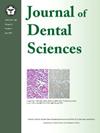插入载荷对插入转矩值的影响
IF 3.1
3区 医学
Q1 DENTISTRY, ORAL SURGERY & MEDICINE
引用次数: 0
摘要
背景/目的本研究通过评估不同种植体设计的植入扭矩和植入时间,探讨植入负荷对种植体初级稳定性的影响。材料与方法试验了四种种植体设计,包括一种圆柱形标准种植体(S),两种混合种植体锥形效应(TE)和骨水平(BL),一种锥形骨水平锥形种植体(BLT)。上颌后牙区采用聚氨酯骨模型。在最小载荷和5.0牛顿(N)载荷两种载荷条件下,记录植入扭矩值(ITV)和插入时间(定义为从植入开始到平台对准的时间)。利用扭矩计捕捉扭矩-时间曲线,计算ITV的均值和标准差。数据分析采用配对t检验(P <;0.05)。结果不同设计的最小插入载荷不同:种植体S需要2.5 N,种植体TE和种植体BL各需要2.0 N,种植体BLT需要1.0 N。最小载荷下,种植体S的插入扭矩为8.68 N cm,种植体TE为6.64 N cm,种植体BL为12.29 N cm,种植体BLT为29.52 N cm。在5.0 N条件下,分别为8.12、7.82、14.89和30.53 N cm。植入时间从1.0 N到5.0 N减少了12.52%,种植体BLT有显著差异。结论混合种植体对载荷变化更敏感。在种植体设计的基础上优化植入负荷可以提高临床效果。植入负荷是影响初级种植体稳定性的一个关键因素,但往往被忽视。本文章由计算机程序翻译,如有差异,请以英文原文为准。
Effect of insertion load on insertion torque value
Background/Purpose
This study examined the effect of insertion load on implant primary stability by evaluating the insertion torque and insertion time in various implant designs.
Materials and methods
Four implant designs were tested, including one cylindrical implant standard (S), two hybrid implants tapered effect (TE) and bone level (BL), and one conical implant bone level tapered (BLT). Polyurethane bone models of the maxillary posterior region were used. Insertion torque value (ITV) and insertion time, defined as the duration from implant placement initiation to platform alignment, were recorded under two load conditions, the minimum load and a load of 5.0 newton (N). A torque meter was used to capture torque–time curves, and the mean and standard deviation of ITV were calculated. Data were analyzed using a paired t-test (P < 0.05).
Results
The minimum insertion load varied by design: implant S required 2.5 N, implants TE and BL each required 2.0 N, and implant BLT required 1.0 N. At minimum load, insertion torque was 8.68 N cm for implant S, 6.64 N cm for implant TE, 12.29 N cm for implant BL, and 29.52 N cm for implant BLT. Under 5.0 N, the values were 8.12, 7.82, 14.89, and 30.53 N cm, respectively. Insertion time decreased by up to 12.52 % from 1.0 N to 5.0 N, with significant differences in implant BLT.
Conclusion
Hybrid implants are more sensitive to load variations. Optimizing the insertion load based on implant design can enhance clinical outcomes. The insertion load is a critical but often overlooked factor in primary implant stability.
求助全文
通过发布文献求助,成功后即可免费获取论文全文。
去求助
来源期刊

Journal of Dental Sciences
医学-牙科与口腔外科
CiteScore
5.10
自引率
14.30%
发文量
348
审稿时长
6 days
期刊介绍:
he Journal of Dental Sciences (JDS), published quarterly, is the official and open access publication of the Association for Dental Sciences of the Republic of China (ADS-ROC). The precedent journal of the JDS is the Chinese Dental Journal (CDJ) which had already been covered by MEDLINE in 1988. As the CDJ continued to prove its importance in the region, the ADS-ROC decided to move to the international community by publishing an English journal. Hence, the birth of the JDS in 2006. The JDS is indexed in the SCI Expanded since 2008. It is also indexed in Scopus, and EMCare, ScienceDirect, SIIC Data Bases.
The topics covered by the JDS include all fields of basic and clinical dentistry. Some manuscripts focusing on the study of certain endemic diseases such as dental caries and periodontal diseases in particular regions of any country as well as oral pre-cancers, oral cancers, and oral submucous fibrosis related to betel nut chewing habit are also considered for publication. Besides, the JDS also publishes articles about the efficacy of a new treatment modality on oral verrucous hyperplasia or early oral squamous cell carcinoma.
 求助内容:
求助内容: 应助结果提醒方式:
应助结果提醒方式:


